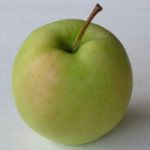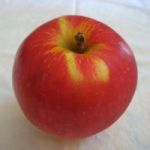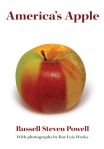EARLY SEASON APPLES have come a long way in the past 50 years. Today, there are a number of excellent choices to satisfy people’s palettes as they await the arrival of the traditional fall apples like McIntosh and Cortland.
These newer early season varieties taste better and last longer than many of their predecessors. Here are six of the best:

Akane (ah-KAH-neh) was discovered in Japan in 1937, but it was not released commercially until 1970. It has beautiful red color with occasional yellow streaks, and sweet-tart flavor with hints of strawberry. Crisp and juicy, Akane is good for both eating and cooking, as it holds it shape well. Akane is the result of a cross between two heirloom varieties: Jonathan, which supplies Akane’s rich red color, and Worcester Pearmain, which contributes its strawberry flavor.

Ginger Gold was discovered as a chance seedling at a Virginia orchard in 1969; based on its characteristics and where it was found, it may be a cross between Golden Delicious and Newtown Pippin. It has yellow-green skin and is crisp and juicy. Ginger Gold’s flavor is more sweet than tart. It is good for both cooking and fresh eating, and its flesh browns slowly when sliced, making it especially good in salads.

Pristine was developed at Purdue University in Indiana in 1975, and released commercially in 1994. Yellow with an occasional pink blush, Pristine’s sweet-tart flavor has hints of citrus. It is crisper and stores better than many early season varieties. Its parentage is obscure, a cross between an unnamed seedling and Camuzat, a little-known apple from Spain.

Sansa is another red apple with yellow streaking, although it sometimes can be deep pink. It is the product of a 1970 collaboration between researchers in Japan and New Zealand, and it was released commercially in 1988. It is sweet and juicy, with just a little tang, and it is considered best for fresh eating. Sansa is a cross between, Akane, which contributes to its red color, and Gala, which lends it sweetness.

Williams’ Pride is another apple developed at Purdue’s joint apple-breeding program with Rutgers University in New Jersey and the University of Illinois. It was discovered in 1975 and released commercially in 1988. Maroon red, it is crisp and juicy, with a spicy, sweet-tart taste. It is considered a good all-purpose apple and is especially good for fresh eating. Williams’ Pride is the result of a complex cross that includes Jonathan, Melba, Mollie’s Delicious, and Rome.

Zestar! is the newest of this early bunch, developed in 1999 at the University of Minnesota. It is mostly red in color over a yellow base. Crisp and juicy, its flavor is more sweet than tart. A good all-purpose apple, Zestar! is the trademarked name for the variety, which resulted from a cross of an unknown seedling with State Fair, a little-known apple native to Minnesota.
* * *
VISITORS to Farm Fresh Fest at Wachusett Mountain in Princeton, Massachusetts, this weekend, will have a chance to taste some of these outstanding early season apples at the New England Apple Association booth. In addition to fresh apples, there will be apple baked goods and other apple treats.
Executive Director Bar Lois Weeks and Senior Writer Russell Steven Powell will be on hand to talk about apples and the upcoming season, 10 a.m. to 5 p.m. Saturday, August 29, and Sunday, August 30.
* * *
NEW ENGLAND expects a good apple crop in 2015.
The U. S. Apple Association estimates the 2015 New England apple crop at 4.03 million 42-pound boxes, 18 percent higher than the region’s five-year average of 3.42 million-boxes. The crop is expected to be about 14 percent larger than 2014’s fresh harvest of 3.55 million boxes.
Growing conditions were outstanding in early spring and summer, with good weather during the pollination period throughout the region, and little or no damage from frost. Parts of New England have been dry for the past month, notably areas of Connecticut and New Hampshire, and there has been scattered hail damage in some areas, but over all the crop is shaping up nicely.
The timing of the New England apple harvest so far is on schedule, with early varieties like Akane, Ginger Gold, Pristine, Sansa, Williams’ Pride, and Zestar! already being picked. McIntosh, which accounts for about two-thirds of the crop, is expected to be available by Labor Day Weekend or soon thereafter in most areas.
To find detailed listings of area orchards, visit the home page of the New England Apples website, and click on “Find an Apple Orchard.” Be sure to call ahead to see what is ready for picking.
Most of the region’s orchards expect to have plenty of apples in a range of varieties and sizes.
Here is USApple’s state-by-state forecast for 2015 (in units of 42-pound boxes):
| 2015 crop estimate | 2014 harvest | % change from 2014 | 5-year average | % change from 5-year average | |
| Connecticut | 631 K | 474K | +33% | 516 K | +22% |
| Maine | 1,000 K | 905K | +11% | 738 K | +35% |
| Massachusetts | 1,121 K | 1,031K | +9% | 906 K | +24% |
| New Hampshire | 495 K | 402K | +23% | 461 K | +7% |
| Rhode Island | 55 K | 43K | +28% | 53 K | +4% |
| Vermont | 729 K | 700K | +4% | 750 K | -3% |
The 2015 United States apple crop is predicted to be 234.8 million boxes, about 14 percent smaller than 2014, according to USApple’s annual forecast. Leading the way is Washington state, with an estimated crop of 143 million boxes, about 18 percent smaller than a year ago. New York expects to harvest 26.2 million boxes, a 15 percent decrease from 2014, and Michigan will be slightly down from a year ago, at 24,000 million boxes.
The 2015 national apple crop forecast is close to the five-year average of 236,008 million boxes.
* * *
TWO RECENT BOOKS by Russell Steven Powell, senior writer, and Bar Lois Weeks, executive director of the New England Apple Association, explore the history of apple growing in the region and look at the nation’s apple industry.
 Apples of New England (Countryman Press) is an indispensable resource for anyone searching for apples in New England orchards, farm stands, or grocery stores — or trying to identify an apple tree in their own backyard.
Apples of New England (Countryman Press) is an indispensable resource for anyone searching for apples in New England orchards, farm stands, or grocery stores — or trying to identify an apple tree in their own backyard.
The book contains color photographs by Weeks and descriptions of more than 200 apples discovered, grown, or sold in New England, accompanied by notes about flavor and texture, history, ripening time, storage quality, and best use. Apples of New England offers practical advice about rare heirlooms and newly discovered apples.
Apples of New England includes chapters on the rich tradition of apple growing in New England, and on the “fathers” of American apples, Massachusetts natives John Chapman (“Johnny Appleseed”) and Henry David Thoreau. Apples of New England presents the apple in all its splendor: as a biological wonder, as a super food, as a work of art, and as a cultural icon.
 America’s Apple (Brook Hollow Press) tells a rich and detailed story about apple growing in America, from horticulture to history to culinary uses. Powell writes about the best ways to eat, drink, and cook with apples. He describes the orchard’s beauty and introduces readers to some of the family farms where apples are grown today, many of them spanning generations.
America’s Apple (Brook Hollow Press) tells a rich and detailed story about apple growing in America, from horticulture to history to culinary uses. Powell writes about the best ways to eat, drink, and cook with apples. He describes the orchard’s beauty and introduces readers to some of the family farms where apples are grown today, many of them spanning generations.
America’s Apple looks at how America’s orchards are changing as a result of the trend toward intensive planting and the trademarking of new varieties, and what that means to consumers. Powell also writes about the fragile underpinnings of modern agriculture: the honeybees needed to pollinate the crop and the labor required to pick it, plus new and exotic pests and increasingly volatile weather.
Apples of New England and America’s Apple are available in hardcover at fine bookstores and orchards and online. America’s Apple is also available in paperback.
For more information, write to newenglandapples@verizon.net.